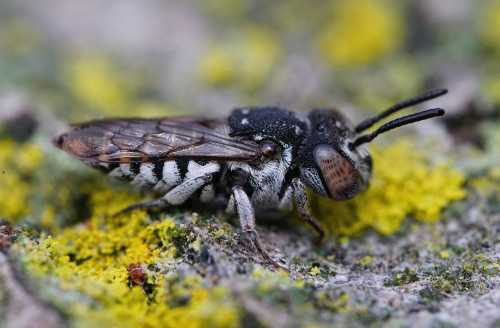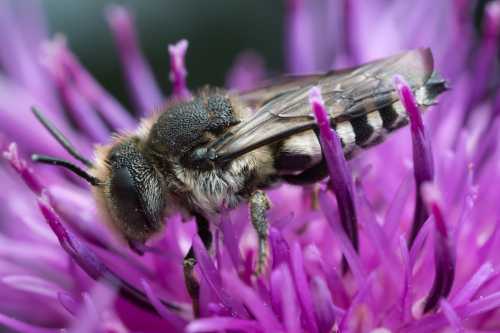Coelioxys - Sharp-tail Bees
Female Coelioxys - sharp-tail bees (or sharp-tailed bees), are especially identifiable by their distinctive pointy abdomens, yet their general appearance is perhaps something of a departure from the usual image most people have in mind when they think of bees.
So what do we know about them?
About Coelioxys - Sharp-tail Bees
6 Quick Facts:
- The word 'Coelioxys' is Greek for "sharp belly"1.
- Females have sharp pointy tails, the tails of males are a little blunter, but feature small spines.
- Like honey bees, sharp-tail bees have hairy eyes2.
- Coelioxys species are cleptoparasites, and as such, rely on other bee species for the rearing of offspring1,2,3.
- Coelioxys species are found around the world. Wilson & Messinger-Carill1 suggest there are over 500 species worldwide.
- Sharp-tail bees belong in the Megachilidae family (the leafcutters).
Appearance
Whilst females have sharp points to their tails (which is useful in securing the safety of her eggs), the tails of males are blunter, but they have short, visible spines near to the tip when viewed closely.
 Coelioxys acanthura - an obvious female, with the pointed tail especially visible.
Coelioxys acanthura - an obvious female, with the pointed tail especially visible. Coelioxys acanthura - A male, as can be identified by the tiny spines at the end of the tail, just visible.
Coelioxys acanthura - A male, as can be identified by the tiny spines at the end of the tail, just visible.Nevertheless, some species can have shorter, somewhat stumpy abdomens, but even in such cases, the abdomen of the female ends in a sharp point. This can be seen for example, in the female short sharp-tail bee (Coelioxys afra) - a species found in Britain and Europe, also recorded in South Africa and other regions.
 Female of the short sharptail bee Coelioxys afra. This species also has a reddish-brown tinge to the end of the tail.
Female of the short sharptail bee Coelioxys afra. This species also has a reddish-brown tinge to the end of the tail.As previously stated, a further characteristic of note is that like honey bees, Coelioxys have hairy eyes2.
Nesting habits of sharp-tail bees
Like bees of the Nomada genus, Coelioxys are cleptoparasites.
An adult female sneaks into the open nest of a target solitary bee host, usually a Megachile species (leafcutters) or Anthophora (flower bees) whilst the nest is still in the process of being provisioned with food stores.
This usually happens when the host female is foraging away from the nest.
 A Coelioxys bee (possibly Coelioxys conoidea - large sharp-tail bee). Again, this is a male, as can be seen from the small spines at the end of the tail.
A Coelioxys bee (possibly Coelioxys conoidea - large sharp-tail bee). Again, this is a male, as can be seen from the small spines at the end of the tail.Why is the egg of the sharp-tail bee (Coelioxyx) unnoticed by the host bee?
Not only do Coelioxys females have to avoid being seen themselves by the target host, but her egg must also be hidden.
To achieve this, the egg-laying female uses her pointy tail to create a slit in the wall of a nest cell. Her egg is then deposited into the slit and hence concealed in the cell wall. Having hidden her egg inside the cell wall, she then leaves the host nest.
Additionally, it is thought the textured surface of the egg helps disguise it inside the cell wall3.
The host female returns, and after she has gathered sufficient food ready for the larvae that will hatch from her own egg, she seals up the nest entrance, and leaves.
What happens to the eggs and larvae of the host bee?
Of course, the host bee has only provided sufficient food for one developing larva inside each cell - her own, but there are now two eggs inside the cell.
This would obviously mean there would be competition between the host offspring, and that of the sharp-tail bee if both hatch at the same time.
However, the egg of the sharp-tail bee will hatch almost immediately. The developing larva of the cleptoparasite then kills the host's offspring with their large, curved, sharp, mandibles (jaws), destroying any remaining egg or larva of the host, and consumes the food stores intended for them.
 Another view of a female Sharp-bellied bee, Coelioxys acanthura. Note the sharp point at the end of the tail.
Another view of a female Sharp-bellied bee, Coelioxys acanthura. Note the sharp point at the end of the tail.Foraging habits
Depending on species and habit, Coelioxys visit a range of flowers, including brambles, thymes, bird's-foot-trefoils, Viper's-bugloss, mallows, knapweeds, Sea holly, Common Fleabane, White bryony, and Marjorams.
Distribution: How many Coelioxys species are there, and where are they found?
There are over 500 species worldwide1.
They are abundant in South America, but are also found in the USA, Canada, and across Europe.
- 45 species in the United States, 10 in Canada1.
- 8 species in Britain2.
References
1. Wilson & Messinger Carril - The Bees In Your Backyard.
2. Field Guide to Bees Of Great Britain And Ireland by Steven Falk.
3. Litman JR. Under the radar: detection avoidance in brood parasitic bees. Philos Trans R Soc Lond B Biol Sci. 2019 Apr 1;374(1769):20180196. doi: 10.1098/rstb.2018.0196. PMID: 30967087; PMCID: PMC6388046.
If you found this page helpful or interesting, I'd really be grateful if you would share it with others - if not this page, perhaps another, such as Gardening For Bees.
Thank you so much :) .



